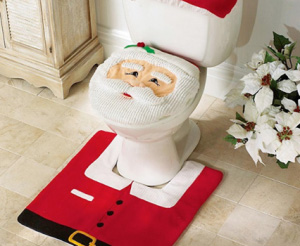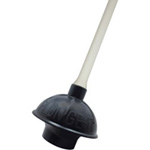Three quick-fix plumbing tricks if disaster strikes over the holidays
In many cases, a plumbing emergency really isn’t an emergency. Sometimes you just need to know the tricks of the trade to get things moving along or to tide you over until the experts arrive.
We’re not saying that you shouldn’t call your plumber to fix the following situations. Quite often, you’ll need to get somebody out for a permanent solution. However, no-one likes being dragged out of bed at 2am, so having some handy tricks in your DIY plumbing bag can be super useful.
So if one of these common plumbing emergency strikes over the holidays, here are our top three tips to tackle the challenge until your local miracle worker can make his or her way to you.
How to clear a blocked toilet
 If the kids have been a little too enthusiastic with the toilet paper, or Grandpa Joe’s been a little too enthusiastic with Christmas lunch, the aftermath might not be pretty. A blocked toilet on Christmas Day is not a joy to the world, but it’s also not a disaster. Here’s a couple of things you’ll need to know to get the party started again.
If the kids have been a little too enthusiastic with the toilet paper, or Grandpa Joe’s been a little too enthusiastic with Christmas lunch, the aftermath might not be pretty. A blocked toilet on Christmas Day is not a joy to the world, but it’s also not a disaster. Here’s a couple of things you’ll need to know to get the party started again.
First things first – assess the situation. If the toilet has overflowed, you need to get in there and clean it up. Grab some gloves, towels, and a mop and bucket. Make it as clean as possible. All surfaces that have come in contact with toilet water will need to be disinfected. And keep the cleaning stuff handy – you may need them again.
Secondly – is the toilet completely blocked? During the time it’s taken you to clean up the floor and surrounds, has the level of toilet water gone down? If no, you’ve got a no-drainer. If it’s slowly disappearing, you’ve got a slow drainer.
So… time to make clearing it a no-brainer!
Clearing a blocked toilet: To plunge or not to plunge
 Every home should have at least two plungers – one for the sinks and one for the toilet. Yep, they’re different.
Every home should have at least two plungers – one for the sinks and one for the toilet. Yep, they’re different.
A sink plunger is the traditional cup looking one. A toilet plunger (flange plunger) has a soft, rubber flap extension on the end. Not only does it allow for better suction, but it also makes it easy to differentiate between the two; because using the same plunger on the toilet and the sink… eew!
So, if you have a toilet plunger follow these steps for a successful unblock:
- Don’t be too enthusiastic on the first plunge – make it a gentle one. The bell on the plunger is going to be full of air. Anything too hard will force the air out of the seal and you’ll be quickly covered in toilet water. Not pretty.
- Once you’ve got the first lot of air out, then you can go for your life (making sure the seal is intact). Most blockages will loosen with 15-20 plunges. Try changing the pace every now and then.
- Make sure there’s enough water in the bowl at all times. The plunger needs to stay covered, or else it’s not going to be effective.
What if you don’t have a toilet plunger? And what if the toilet plunger isn’t working?
If you’re pretty sure that the blockage is a wad of toilet paper, common dishwashing liquid, or shampoo and hot water, do wonders. Yep – you heard us right. So long as the toilet isn’t overflowing, pour a good amount of shampoo or liquid soap into the toilet. Add about 2L of very hot (not boiling) water to the bowl and then walk away for about five minutes. The hot water breaks down the toilet paper and the soap should help it disappear down the pipe. You can now give it another go with a plunger, or use an unravelled wire coat hanger to push the blockage further down the line. Repeat a couple of times if necessary, and everyone should be good to start going again.
If it becomes an ongoing problem you’re going to need to get someone to find out what’s causing the issue. Oh, and invest in a toilet plunger, if you don’t have one.
How to clear a blocked kitchen drain
If you’re one to regularly pour tea leaves, coffee grounds or cooking grease down the drain, at some point your sink is going to decide enough is enough and fight back. You really don’t want this happening right in the middle of preparing Christmas dinner. In this instance, a little forethought can go a long way.
If you know you’re going to be cooking up a storm over the next couple of days, and you’re going to wash things down the sink that you normally wouldn’t, a little pre-maintenance may make the difference. Instead of reaching for the toxic cleaners, try placing a combo of one cup bicarb soda and ½ cup salt down the drain. Let it sit overnight and, in the morning, pour two cups of boiling water down the drain. This should be enough to give it a good cleanout. The bicarb absorbs and cleans, the hot water melts the grease, and the salt acts as a mild abrasive to help wash everything away.
If a blockage occurs while you’re in the middle of your celebrations (and you don’t have a plunger), you can try pouring some dishwashing detergent followed by boiling water down the drain to remove a build-up of fat, oil or grease. This has been shown to work better than the common DIY trick of bicarb and vinegar. If the blockage is caused by a build-up of food waste, try using a hooked coat hanger to form a ‘snake’ and push or pull the blockage apart.
How to make a temporary (emergency!) fix to a burst water pipe
Uh-oh! A burst water pipe is bound to cause a fair amount of cursing and swearing at the best of times. On a day when the hardware store is closed and the plumbers aren’t answering their phones, there’s a quick trick or two to be had, depending if the pipe is copper or PVC.
Fixing a copper pipe
- Find the mains, turn the water off, and find the leak.
- If we’re talking a small hole, a lead pencil and some duct tape can work wonders for a short time. Sharpen the pencil, insert the lead into the hole and then snap it off to form a seal. Wrap with duct tape and call a plumber at the next available opportunity.
- If the hole is larger, find yourself an old piece of rubber (like an inner tube) and wrap it around the pipe, covering the hole. Use a C-clamp and two small blocks of wood to clamp the rubber in place. You can also use a piece of garden hose to the same effect.
Fixing a PVC pipe
- Find the mains, turn the water off, and find the leak.
- A small leak in a non-pressurised pipe can be fixed with a good wrapping of duct tape. This will hold for a couple of days until you get some epoxy or replacement pipe.
Here’s to a holiday free from plumbing emergencies!
So, if leakage or blockage is looking to put a dampener on your day, you know you’ve got some tricks up your DIY sleeve to fix the problems. By using trusty items from around the house, a Christmas crisis can be averted. But just in case, it wouldn’t hurt to ask Santa for any missing items from our ‘DIY Plumbing Kit’.
Has a special day ever been ruined by a plumbing disaster?
Have you ever had a special day ruined by a plumbing disaster? We’d love to hear what happened and how you fixed it – we’re always up to learning how necessity is the cause of all invention!

